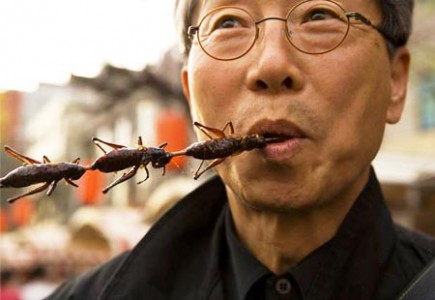
The thought of climate change may leave you with a sinking feeling in your stomach, what with rising sea levels and increasing extinction rates. Research published recently in PLoS has suggested a novel way of helping the planet, although it is unlikely to help the situation in your stomach. Eating insects can, apparently, reduce our individual carbon footprint, by removing our dependency on carbon-intensive sources of protein (like a nice juicy steak or a crispy bacon sarnie).
The livestock sector is one of the most prolific producers of greenhouse gases, amounting up to around 18% of total greenhouse gas emissions. The rearing of livestock also results in the production of 65% of the world’s Nitrous Oxide, through the breakdown of manure and urine. This is especially concerning, since Nitrous Oxide is almost 300x more potent a greenhouse gas than CO2.
Insects, on the other hand, require much less energy to produce and so emit less pollution. Whereas cows, pigs and other mammals regulate their own body temperature (which takes a lot of energy to do so), insects are poikilotherms – they stay at the same temperature as their environment. This lets the insects convert more of their food into growth, rather than waste products.
The scientists bred mealworms, locusts and crickets in order to measure, for the first time, the amount of greenhouse gases they were producing. The house cricket, it turns out, produce 8–13 times less ammonia than pigs. Mealworms produced an astounding 375 times less CO2 than cows. Locusts produced 2- 60 times less Nitrous Oxide than pigs. They are also high in protein and low in fats and make almost the perfect snack.
Maybe the thought of tucking into some mealworms for your evening meal leaves you feeling queasy (it certainly does for me), but it may surprise you to know that most of the world does not share our opinion. 80 per cent of the world’s population eats insects on a regular basis. This occur particularly frequently in the developing world where insects are a cheap and plentiful supply of protein. As the study’s lead author, Dennis Oonincx, points out “If you look at the edible caterpillar industry in Africa, it’s a million dollar business.”
Eating insects may even become a necessity for most in the near future. As the population of the planet increases, there is an increasing demand for land. Cattle production is land-intensive, inefficient and expensive, and is expected to decline in the late 21st century (See FAO). With less land area for meet production, insects may very well take up the demand for protein consumption.
If eating insects really is the future, we might as well start getting used to it now. I thought I would leave you with a recipe you can all try at home: Woodlice Scones.
You will need:
- 25grams of butter
- 2 cups of flour
- 2 teaspoons of baking powder
- 2 rashers of bacon
- 1/2 a medium sized onion
- 3/4 of a cup of milk
- 2 tablespoons of killed woodlice
Mix flour and baking powder in a bowl. Add butter and rub into dry ingredients. Add bacon, onion and woodlice, mix in and then add all the milk. Mix – the dough should be soft enough to roll out onto the bench top. Add extra milk or flour as required.
Roll/press out into a 20-24cm square, cut into nine squares and bake at 200C for 10-15 minutes.
Happy Eating.
